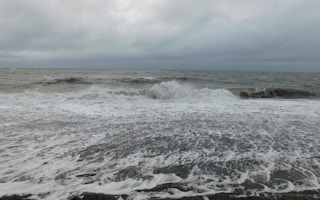The Arctic Ocean is changing, and changing fast. By the century’s end, the maximum height of storm waves in the polar seas could have risen by twice or even three times the present height.
According to new research, wave heights could increase by two metres and coastal floods could become four times, or even 10 times, as frequent.
And a separate study has found that even the character of the water in the ocean is changing: warm salty water from the Atlantic is weakening the ice cover at an accelerating rate, but providing more nutrients for Arctic life, while extra river water from the Pacific has made the American-Asian part of the Arctic Ocean less likely to mix, and less biologically productive.
The Arctic is warming at twice the rate of the planet as a whole: the ice cover has been thinning and retreating for decades. And temperatures keep on rising.
One Siberian town recorded a temperature of 38°C in June, and the region has been hit by devastating forest fires.
And as the oceans warm, winds become more powerful and the ocean waves respond, with prospects of ever-greater hazard for shipping and coastal settlements.
Extreme wave events that once occurred in the Arctic at average intervals of once every 20 years could by the end of the century happen every two to five years, according a study in the Journal of Geophysical Research: Oceans.
“It increases the risk of flooding and erosion. It increases drastically almost everywhere”, said Mercè Casas-Prat, a researcher with Environment and Climate Change Canada. “This can have a direct impact on communities that live close to the shoreline.”
She and a colleague used computer simulations and a range of climate predictions to work out what will happen to those ocean surfaces not covered by ice as the seas warm in response to greenhouse gas emissions from fossil fuel combustion.
They found that almost everywhere in the Arctic would experience greater wave height. The hardest-hit would be the Greenland Sea, bounded by the largest body of ice in the northern hemisphere, and the Svalbard Archipelago.
More salty water
Maximum annual wave heights could increase by as much as six metres.
“At the end of the century, the maximum will on average come later in the year and also be more extreme,” Dr Casas-Prat said.
The Arctic Ocean covers only about 3 per cent of the planet’s surface, but it is vulnerable to change in ocean regions much nearer the Equator. US and Scandinavian scientists report in the journal Frontiers in Marine Science that they looked at 37 years of direct observation and measurement to find that not only are Arctic waters changing: they are changing in different ways.
Flows of increasingly warm salty water from the Atlantic have begun to mix at depth, weaken sea ice and bring deeper, nutrient-rich water to the surface. At the other entrance to the partly landlocked expanse of water, an increasing flow from rivers has begun to make the separation of surface and deep layers even more pronounced.
This limits the movement of nutrients to the surface, protentially making that part of the sea less biologically rich. Many marine creatures from low latitudes are moving north, in some cases replacing local species. The changes could affect fisheries, tourism, navigation and of course the people who live in the Arctic.
“In many respects, the Arctic Ocean now looks like a new ocean,” said Igor Polyakov, an oceanographer at the University of Fairbanks, Alaska, who led the research.
This story was published with permission from Climate News Network.

















